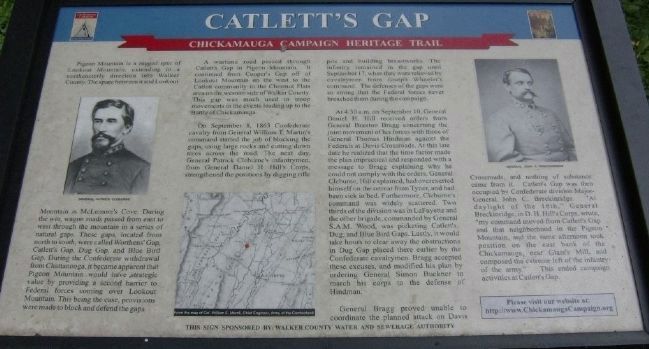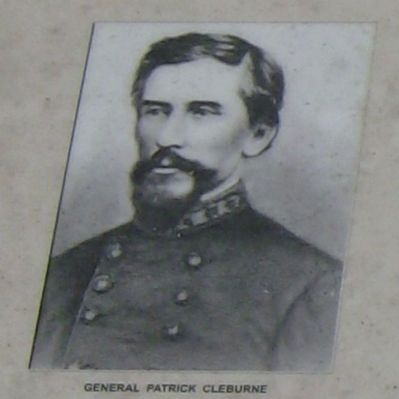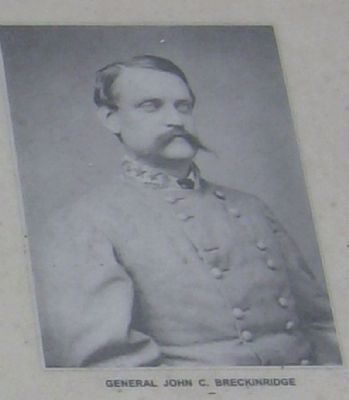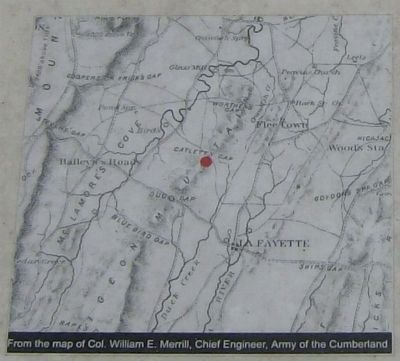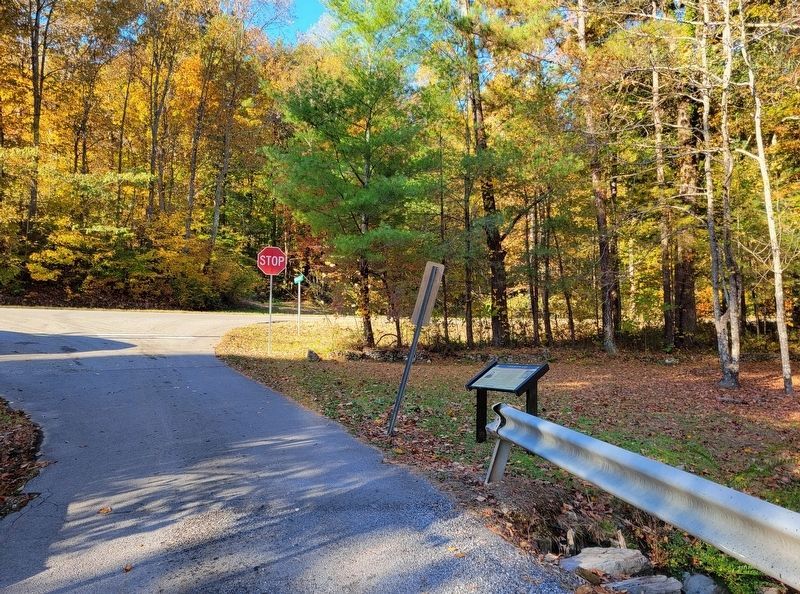Near LaFayette in Walker County, Georgia — The American South (South Atlantic)
Catlett’s Gap
Chickamauga Campaign Heritage Trail
A wartime road passed through Catlett’s Gap in Pigeon Mountain. It continued from Cooper’s Gap off of Lookout Mountain on the west to Catlett community in the Chestnut Flats area on the western side of Walker County. This gap was much used in troop movements in the events leading up to the Battle of Chickamauga.
On September 8, 1863 Confederate cavalry from General William T. Martin’s command started the job of blocking the gaps, using large rocks and cutting down trees across the road. The next day, General Patrick Cleburne’s infantrymen, from General Daniel H. Hill’s Corps, strengthened the positions by digging rifle pits and building breastworks. The infantry remained in the gap until September 17, when they were relieved by cavalrymen from Joseph Wheeler’s command. The defenses of the gaps were so strong that the Federal forces never breached them during the campaign.
At 4:30 a.m. on September 10, General Daniel H. Hill received orders from General Braxton Bragg concerning the joint movement of his forces with those of General Thomas Hindman against the Federals at Davis Crossroads. At this late date he realized that the time factor made the plan impractical and responded with a message to Bragg explaining why he could not comply with the orders. General Cleburne, Hill explained, had overexerted himself on the retreat from Tyner, and had been sick in bed. Furthermore, Cleburne’s command was widely scattered. Two thirds of the division was in LaFayette and the other brigade, commanded by General S.A.M. Wood, was picketing Catlett’s, Dug, and Blue Bird Gaps. Lastly, it would take hours to clear away the obstructions in Dug Gap placed there earlier by the Confederate cavalrymen. Bragg accepted these excuses, and modified his plan by ordering General Simon Buckner to march his corps to the defense of Hindman.
General Bragg proved unable to coordinate the planned attack on Davis Crossroads, and nothing of substance came from it. Catlett’s Gap was then occupied by Confederate division Major-General John C. Breckinridge. “At daylight of the 18th,” General Breckinridge, in D.H. Hill’s Corps, wrote, “my command moved from Catlett’s Gap and that neighborhood in the Pigeon Mountain, and the same afternoon took position on the east bank of the Chickamauga, near Glass’s Mill, and composed the extreme left of the infantry of the army.” This ended the campaign activities at Catlett’s Gap.
Erected by Chickamauga Campaign Heritage Trail.
Topics and series. This historical marker is listed in this topic list: War, US Civil. In addition, it is included in the Chickamauga Campaign Heritage Trail series list. A significant historical month for this entry is September 1942.
Location. 34° 45.377′ N, 85° 18.222′ W. Marker is near LaFayette, Georgia, in Walker County. Marker is at the intersection of Dripping Springs Road and Georgia Route 136 on Dripping Springs Road. Touch for map. Marker is at or near this postal address: 4646 Old Mineral Springs Rd, La Fayette GA 30728, United States of America. Touch for directions.
Other nearby markers. At least 8 other markers are within 4 miles of this marker, measured as the crow flies. Skirmish at McLemore’s Cove (approx. 2.9 miles away); a different marker also named Skirmish at McLemore’s Cove (approx. 2.9 miles away); a different marker also named Skirmish at McLemore’s Cove (approx. 2.9 miles away); Fort Cumming (approx. 3 miles away); Marsh-Warthen House (approx. 3½ miles away); African American Pioneers of the Marsh-Warthen-Clements House (approx. 3½ miles away); To Our Confederate Soldiers (approx. 3½ miles away); The Marsh House (approx. 3½ miles away). Touch for a list and map of all markers in LaFayette.
More about this marker. Chickamauga Campaign Heritage Trail - Army of Tennessee site #6
Also see . . . Chickamauga Campaign Heritage Trail Website. (Submitted on October 2, 2008, by David Tibbs of Resaca, Georgia.)
Credits. This page was last revised on October 27, 2022. It was originally submitted on October 2, 2008, by David Tibbs of Resaca, Georgia. This page has been viewed 1,907 times since then and 85 times this year. Last updated on June 16, 2022, by Bradley Owen of Morgantown, West Virginia. Photos: 1, 2, 3, 4. submitted on October 2, 2008, by David Tibbs of Resaca, Georgia. 5. submitted on October 27, 2022, by Bradley Owen of Morgantown, West Virginia. • Bernard Fisher was the editor who published this page.
